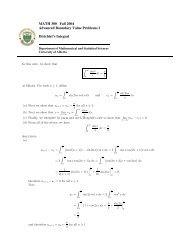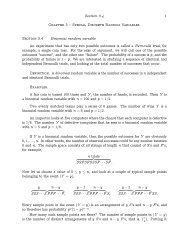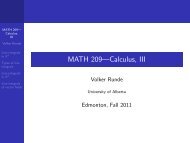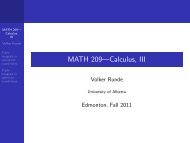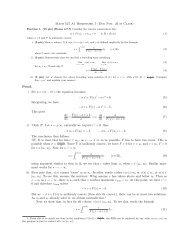Math 411: Honours Complex Variables - University of Alberta
Math 411: Honours Complex Variables - University of Alberta
Math 411: Honours Complex Variables - University of Alberta
Create successful ePaper yourself
Turn your PDF publications into a flip-book with our unique Google optimized e-Paper software.
114 CHAPTER 17. THE RIEMANN MAPPING THEOREM<br />
Let z0 ∈ D1 and let w0 := f(z0). We see that f ′ is differentiable at z0 only if<br />
f ′ (z0) �= 0: for w ∈ D2 \{w0},<br />
f −1 (w)−f −1 (w0)<br />
w −w0<br />
=<br />
f −1 (w)−f −1 (w0)<br />
f(f −1 (w))−f(f −1 (w0)) −→<br />
w→w0<br />
1<br />
f ′ (z0) .<br />
Since f is not constant, f ′ is not identically zero and thus Z(f ′ ) is discrete. We<br />
claim that f(Z(f ′ )) is also discrete. Assume that f(Z(f ′ )) is not discrete. Then there<br />
exist w0 ∈ D2 and a sequence (zn) ∞ n=1 in Z(f′ ) such that w0 �= f(zn) for n ∈ N, but<br />
w0 = lim f(zn). By the bijectivity and continuity <strong>of</strong> f<br />
n→∞ −1 , we have f−1 (w0) �= zn for<br />
n ∈ N and f −1 (w0) = lim zn. Hence, f<br />
n→∞ −1 (w0) is a cluster point <strong>of</strong> Z(f ′ ), which is<br />
impossible.<br />
Hence, f−1 is holomorphic on D2\f(Z(f ′ )). Since f−1 is continuous and f(Z(f ′ ))<br />
is discrete, Riemann’s Removability Criterion then yields the holomorphy <strong>of</strong> f−1 on<br />
all <strong>of</strong> D2. Thus Z(f ′ ) = ∅.<br />
Corollary 17.2.1. Let D ⊂ C be open and connected, and let f : D → C be<br />
holomorphic and injective. Then Z(f ′ ) = ∅.<br />
Pro<strong>of</strong>. If f is injective, it is not constant. By the Open Mapping Theorem, f(D) is<br />
thereforeopenandconnected. ApplyTheorem17.2withD1 = D andD2 = f(D).<br />
Theorem 17.3 (RiemannMapping Theorem). Let D � C be open and connected and<br />
admit holomorphic square roots, and let z0 ∈ D. Then there is a unique biholomorphic<br />
function f: D → D with f(z0) = 0 and f ′ (z0) > 0.<br />
Pro<strong>of</strong>. Uniqueness: Let g: D → D be another such function. Then f ◦g −1 : D → D is<br />
biholomorphic with (f ◦g −1 )(0) = f(z0) = 0. By Corollary 7.4.1, there exists c ∈ C<br />
with |c|= 1 such that<br />
f(g −1 (z)) = cz<br />
for z ∈ D and thus<br />
f(z) = f(g −1 (g(z))) = cg(z)<br />
for z ∈ D. Differentiation yields f ′ (z) = cg ′ (z) for z ∈ D. Since |c|= 1 and both<br />
f ′ (z0) and g ′ (z0) are real and positive, we conclude that c = 1.<br />
Existence: Let<br />
F := {f: D → D : f is injective and holomorphic with f(z0) = 0 and f ′ (z0) > 0}.<br />
Claim 1. F �= ∅.<br />
Since D �= C, there exists w ∈ C\D. Since D admits holomorphic square roots,<br />
there is a holomorphic function g: D → C such that [g(z)] 2 = z−w for z ∈ D. Note<br />
for z1,z2 ∈ D that g(z1) = ±g(z2) ⇒ z1 = z2. In particular, this means that g is<br />
injective and thus not constant.



